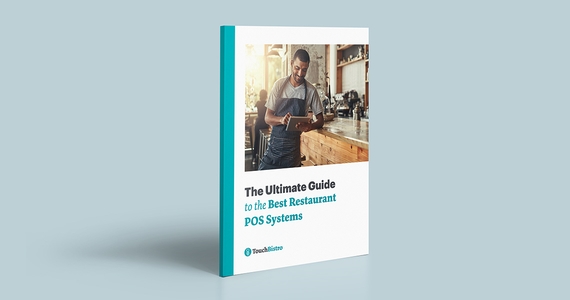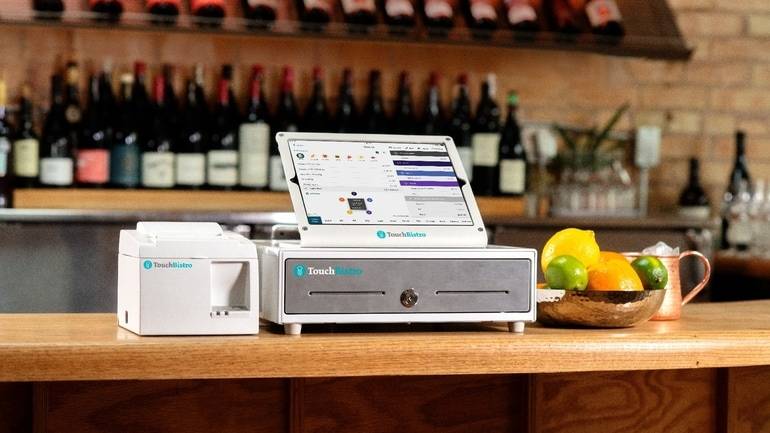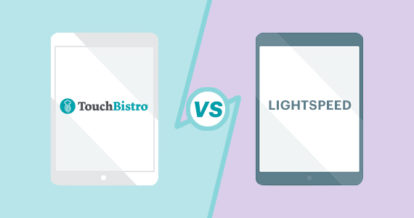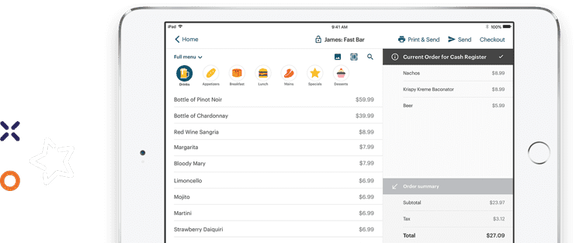Don’t have time to read the full article? Here are the highlights of TouchBistro Restaurant POS vs Lightspeed:
| TouchBistro: – Restaurant-specific solution – Runs on iOS and Apple iPad tablets – Extensive in-house solutions, including integrated reservations – Private company dedicated to small business growth and support – Best for single and multi-location restaurants that are growing and scaling Lightspeed: – Not a restaurant-specific POS solution (originally built for retail) – Runs on iOS and Apple iPad tablets – Heavy reliance on third-party integrations to bridge the gap between its in-house products – Public company invested in increasing shareholder value – Best for restaurants with an integrated retail concept |
If you’re shopping for a new restaurant POS system – or a Lightspeed alternative – you’ll definitely want to compare TouchBistro vs Lightspeed.
Both TouchBistro and Lightspeed are popular POS solutions for restaurants. Not only do the two systems serve a similar audience, but they also offer very similar POS features, including menu management, tableside ordering, advanced reporting, and more.
But while TouchBistro and Lightspeed restaurant POS may seem similar at first glance, there are some important differences between the two systems. These key differences make each system better suited to a very different type of restaurant.
To help you find out which system is the right fit for your restaurant, we’ve laid out a head-to-head comparison of Lightspeed vs TouchBistro. In this review, we’ll cover:
- The foundations of each system
- Core POS features
- Hardware
- Payments
- Other add-on solutions
- Pricing
- Integration partners
- Customer support
Though every restaurant has a different list of “must-haves” versus “nice-to-haves,” this review of TouchBistro vs Lightspeed will help you drill down on the real deal-breakers for your restaurant. To go even deeper and see how TouchBistro stacks up to other top restaurant POS systems, check out our Ultimate Guide to the Best Restaurant POS Systems.
The information contained on this site is accurate as of the time of publication.

Compare the top restaurant POS systems on features, pricing, payments, and more.
TouchBistro vs Lightspeed Restaurant POS: An Overview
There’s no question that TouchBistro and Lightspeed restaurant POS share many similarities. Both POS systems run on an iOS operating system, use Apple’s iPads for POS terminals, and are available in similar regions.
However, when you dig a little bit deeper into the TouchBistro and Lightspeed POS reviews and ratings, there are some important differences worth noting. Below, we’ll provide a brief overview of TouchBistro vs Lightspeed, noting the areas of overlap and parsing through some of the key differences.
| TouchBistro | Lightspeed | |
| POS System | Cloud-based | Cloud-based (hybrid option also available for an additional fee) |
| Operating System | iOS | iOS |
| Regional Availability | CAD, U.S., and more | CAD, U.S, MX, Europe |
| Hardware (Tablets) | iPads | iPads |
1. POS System
Let’s start with the similarities. TouchBistro and Lightspeed are both very similar in that they are both modern, cloud-based POS systems. Cloud-based systems are a major upgrade over the legacy systems of the past, because they give restaurants more freedom to move POS terminals around the restaurant and more flexibility to access data off-site.
Of course, one of the downsides of an Internet-reliant POS system is that you can lose function if the Internet goes down. To solve for this issue, TouchBistro and Lightspeed have taken two slightly different approaches.
To address the issue of Internet-related downtime, Lightspeed gives customers the option to add on a piece of hardware to their system called Lite Server. Essentially, the locally-installed server allows you to continue using Lightspeed’s restaurant POS in the event of an Internet outage – though you still won’t be able to process credit card payments offline. In other words, Lightspeed does give you the option to have an offline mode for your POS, but you will need to pay for it.
Unlike Lightspeed, TouchBistro’s cloud-based POS system features a built-in offline mode. This means that you enjoy the same flexibility and remote capabilities of a strictly cloud-based system, such as tableside ordering and cloud-reporting. But thanks to the built-in offline mode, your POS terminals can still talk to one another and you can continue taking orders and sending information to the kitchen, even when the internet is down. In other words, slow or unreliable internet will never bring service to a standstill thanks to this built-in contingency feature.

2. Operating System
Beyond setup, another important consideration is the operating system that each provider’s POS software runs on.
Though Lightspeed used to exclusively offer its point of sale software for iOS and Apple hardware, a series of recent acquisitions means that the company now offers an Android option as well. Though some operators may appreciate the flexibility to choose their preferred operating system and hardware, it’s worth noting that Lightspeed has not invested extensively in its Android solution, meaning ongoing product development and technical support may be more limited than with the company’s iOS offering.
In contrast, TouchBistro POS only runs on Apple’s iOS operating system and exclusively uses Apple hardware. Unlike Android, iOS is generally considered a more reliable and user-friendly operating system because Apple owns both the hardware (the iPad) and the software (iOS). As a result, there is a seamless integration between the POS software and tablets, so updates roll out automatically across devices. Not to mention, Apple is less frequently the target of malware, which makes it a more secure option than Android-based systems.
3. Regional Availability
Another major similarity between TouchBistro and Lightspeed is the regions in which they operate.
Lightspeed primarily serves the Canada, U.S., Mexico, and European markets, and has customers in more than 100 countries. To support each region, the company has offices in Montreal, New York, Olympia, Ottawa, Santa Cruz, and Belgium.
TouchBisto primarily serves the Canada, U.S., and Mexico markets, though its POS system is used in more than 100 countries. TouchBistro’s POS system is also configured to meet the unique needs of restaurants in each of these countries so you can access region-specific features, integrations, and language settings.
4. Company Structure
When choosing a new POS system, whether a company is public or not may not sound like something that would matter, but it can impact your experience more than you might think.
Lightspeed is a public company that IPOed in March of 2019. Since that time, many of the company’s decisions have been made in the interest of its shareholders, rather than its customers, including laying off nearly 300 of its staff after a negative response to the company’s earnings report. With its renewed focus on profitability, Lightspeed has also begun to invest heavily into its golf course management software, leaving questions about how much of a priority restaurants will be in the company’s future.
In contrast, TouchBistro is a private company, which means its decisions are not driven by a need to satisfy shareholders. Indeed, with its mission to fuel the success of independent restaurants, TouchBistro always has, and continues to, put people before profits.
Core POS Features
| Core POS Features | TouchBistro | Lightspeed |
| Menu Management | ✔ | ✔ |
| Staff Management | ✔ | ✔ |
| Floor Plan Management | ✔ | ✔ |
| Tableside Ordering | ✔ | ✔ |
| Reporting | ✔ | ✔ |
| 1:1 Onboarding | ✔ | ✔ |
| Customer Support | 24/7/365 | 24/7 |
Turning to POS features, both Lightspeed and TouchBistro are equipped with a similar set of core features that includes the following:
- Menu Management: Build and manage multiple menus and menu categories, including modifiers.
- Staff Management: Manage staff with personalized accounts and employee-specific access permissions.
- Floor Plan Management: Design your custom restaurant floor plan, take orders by table, move parties around, split checks, and more.
- Tableside Ordering: Take POS tablets tableside for faster and more accurate order taking.
- Reporting: Get in-depth reporting and analytics on everything from sales to staff activity.
For the most part, both TouchBistro and Lightspeed are equipped with very similar core POS features. However, the level of research and development backing these features is not entirely equal.
Lightspeed was originally founded as a POS and ecommerce software provider for retail businesses. It was not until nine years into business that Lightspeed expanded its offerings to include point of sale software for restaurants as well. And while Lightspeed now serves a number of restaurants, its primary focus remains retail and ecommerce, with a growing interest in the golf sector. In fact, Lightspeed officially changed its name to Lightspeed Commerce Inc. in 2021 to reflect its laser-focus on retail, eCommerce, and driving payments revenue.
Lightspeed’s overwhelming emphasis on the retail sector means that, unlike some of the other POS providers on the market, Lightspeed’s research and development efforts are split between different areas of focus. As a result, some of Lightspeed’s core restaurant POS features are not quite as robust as other solutions on the market and there is less investment in building new solutions for restaurant businesses.
In contrast, TouchBistro is and always has been a restaurant-specific POS. TouchBistro was born out of a desire to create innovative technology that makes running a restaurant easier and has never wavered from this mission. And because TouchBistro only serves the restaurant industry, all of its research and development goes towards continuously improving its core POS features and developing new solutions for restaurateurs. Over time, this has allowed TouchBistro to establish a robust set of core POS features that meet the needs of restaurants big and small.

Hardware
With a basic understanding of what each POS system offers, it’s important to review the hardware itself.
As mentioned, TouchBistro and Lightspeed restaurant POS both use Apple iPad tablets as POS terminals – though Lightspeed does offer some Android solutions. iPads are generally the tablet of choice for most of the top restaurant POS systems, which means that if you’re switching from a TouchBistro or Lightspeed competitor who has an iPad-based POS, you can reuse your existing iPads to save money on hardware costs (as long as the iPads are a compatible generation).
There are many reasons why TouchBistro, Lightspeed, and other top POS providers opt for Apple hardware over Android. The biggest reason is that there’s a seamless integration between Apple’s iPads and its iOS operating system. This integration allows for security updates to roll out automatically across all Apple devices, from phone to desktop, taking the burden off of restaurateurs to continually update their devices.
Beyond the more technical aspects, Apple iPads are perfect for restaurant POS systems because the devices are extremely user-friendly – especially for those who are already familiar with other Apple devices such as iPhones and MacBooks. Even for staff who have never used Apple technology before, Apple’s hardware and software are so intuitive that they’re easy to learn right out of the box.
In addition to iPads, TouchBistro and Lightspeed also offer additional hardware for their restaurant POS systems, including printers, payment terminals, stands, cash drawers, and more. Lightspeed offers all of this hardware in bundles or as individual purchases, whereas TouchBistro’s hardware can only be purchased individually.
Of course, the exact hardware pieces you need will depend on factors such as the type of restaurant you operate, the volume of customers you serve, and the kind of setup you want. Therefore, it’s best to contact each POS provider directly to determine whether you need an entire hardware bundle or whether you may be able to use some of your existing hardware.

Compare the top restaurant POS systems on features, pricing, payments, and more.
Add-On Solutions
While the core POS functions will be enough for some restaurants, other restaurants will need additional features to expand the capabilities of their POS system. This is where add-on features like online ordering, reservations, and customer loyalty programs come in.
Payments
Of all the add-on solutions available to restaurants, integrated payment processing is one of the most important because it’s a functionality that reduces errors and enables deeper customer insights. In fact, TouchBistro’s 2025 State of Restaurants Report found that nearly two-thirds of restaurants use a POS-integrated payments system.
| Payments | TouchBistro | Lightspeed |
| Payments Pricing Model | Fixed rate and interchange plus pricing | Fixed rate pricing |
In the U.S. and Canada, Lightspeed customers can use Lightspeed Payments, which is an integrated payment processing solution powered by the global payments platform Stripe. This integrated solution allows you to accept payment in-venue, tableside, or online, for a quick and seamless solution.
Similarly, TouchBistro also offers an integrated payment processing solution. TouchBistro Payments Powered by Chase is backed by one of the most trusted financial institutions, which means you benefit from Chase’s best-in-class payment processing technology, advanced security, and the support of dedicated payments experts. TouchBistro Payments also boasts competitive rates and supports a variety of use cases, including counter, tableside, and online payments.
Other Add-On Solutions
Beyond payment processing, there are a number of other add-on solutions for restaurant POS systems.
| Add-On Solutions | TouchBistro | Lightspeed |
| Integrated Payments | ✔ | ✔ |
| Inventory | ✔ | ✔ |
| Labor Management and Staff Scheduling | ✔ | ✔ |
| Online Ordering | ✔ | ✔ |
| Integrated Delivery | ✔ | ✘ |
| Delivery Management | ✘ | ✔ (Partnership with Deliverect) |
| Reservations | ✔ | ✘ |
| Gift Cards | ✔ | ✔ |
| Loyalty and Customer Relationship Management | ✔ | ✔ |
| Back Office Management | ✔ | ✔ |
| Marketing | ✔ | ✘ |
| Self-Serve Kiosks | ✘ | ✔ |
| Kitchen Display System | ✔ | ✔ |
| Customer Facing Display | ✔ | ✔ |
| Digital Menu Board | ✘ | ✘ |
When comparing TouchBistro vs Lightspeed, it’s clear that both providers offer similar add-on solutions, including:
- Payments: Integrated or standalone payment processing services.
- Inventory: A POS-integrated solution that automated the inventory tracking and management processing
- Labor Management: Staff scheduling tools and labor automations that make it faster and more cost-effective to manage staff.
- Online Ordering: Customers can order directly from a restaurant’s website and the order is processed through the POS in real-time – commission-free.
- Gift Cards: Branded physical gift cards with multi-location reconciliation.
- Loyalty and CRM: An integrated CRM and rewards program that helps drive repeat visits.
- Marketing: A marketing solution that helps restaurants create and automate custom marketing campaigns.
- Kitchen Display System (KDS): A digital system that displays orders for the back-of-house staff.
- Customer Facing Display: A counter-service system that faces the customer so they can visually confirm their order.
Though TouchBistro and Lightspeed offer many of the same add-on products, there are a couple key differences.
Unlike Lightspeed, TouchBistro offers an end-to-end reservation system and guest management platform called TouchBistro Reservations. TouchBistro Reservations allows guests to make bookings directly through a restaurant’s website or the TouchBistro Dine discovery platform. These reservations then sync directly with your POS to help restaurants manage and optimize their bookings.
TouchBistro also offers a much more robust back office management solution. While Lightspeed offers individual solutions for inventory and accounting, TouchBistro offers an inventory solution, as well as a robust solution for running your entire back office operation.
A perfect companion to your POS, TouchBistro Profit Management is a powerful back office management solution that gives you 360-degree visibility into your entire operation. Powered by automation and driven by data, this fully integrated solution provides you with the tools required to track food costs in real time, process invoices digitally, streamline accounting processes, standardize stock management across multiple locations, and more, all from one centralized platform.

Pricing
No comparison of Lightspeed POS vs TouchBistro POS would be complete without addressing the issue of price.
| Pricing | TouchBistro | Lightspeed |
| Software Pricing | Starting at $69 USD / month for a single license | CAD Pricing Essential: $239 Premium: $499 USD Pricing Essentials: $189 Premium : $399 |
Lightspeed bundles its offerings so you either pay $189 USD for the Essential package, or $399 for the Premium package. The Essential package comes with all the core POS features a single venue restaurant needs, while the Premium package is specifically designed for multi-unit venues.
Keep in mind that while these bundles include all the basic POS features, they don’t include add-on solutions like KDS, accounting, or gift cards. Each of these add-ons will cost you extra (the KDS alone is priced at $40 per month, per screen), so keep this in mind when budgeting how much Lightspeed will set you back each month.
In contrast, TouchBistro’s software starts at $69 USD per month for a single POS terminal. Regardless of how many terminals you add, all of TouchBistro’s packages include the core POS features, unlimited users, free updates, and 24/7/365 support. However, like Lightspeed, you will have to pay an additional monthly fee for any add-on products, such as reservations and online ordering.
Integration Partners
In addition to in-house add-on solutions, TouchBistro and Lightspeed restaurant POS also support various integrations for third-party software. These best-in-class partners offer specialized solutions and services for important functions such as accounting, loyalty, delivery, and more.
| Integration Partners | TouchBistro | Lightspeed |
| Online Ordering and Delivery | ✔ | ✔ |
| Reservations | ✘ (in-house solution) | ✔ |
| Customer Relationship Management and Loyalty | ✘ (in-house solution) | ✔ |
| Staff Management, HR, and Payroll | ✔ | ✔ |
| Inventory Management | ✔ | ✔ |
| Accounting | ✔ | ✔ |
| Reporting and Analytics | ✔ | ✔ |
| Ecommerce | ✘ | ✘ (in-house solution) |
A comparison of TouchBistro vs Lightspeed reveals that both providers offer third-party integrations for the following kinds of solutions:
- Online Ordering and Delivery Marketplaces: Online ordering aggregators, like Deliverect, that sync multiple different third-party ordering apps with your POS system.
- Staff Management, HR, and Payroll: Employee scheduling tools such as 7shifts, as well as payroll providers like Push Operations.
- Inventory Management: Restaurant-specific inventory management tools such as MarketMan, as well as solutions for draft beverage programs like Bevchek.
- Accounting: Accounting tools such as QuickBooks and middleware software like Shogo.
- Reporting and Analytics: Advanced reporting and business insights through software such as Avero.
Beyond those listed above, Lightspeed also offers third-party integrations for a number of other services, including ecommerce, reservations, and marketing. For restaurants with complex needs, such as those that manage a retail operation, these additional integrations can help to expand the capabilities of the POS system.
TouchBistro offers fewer third-party integrations than Lightspeed restaurant POS. However, TouchBistro’s more curated list of integration partners mainly consists of industry-leading solutions that are already used by most restaurateurs. For instance, TouchBistro supports solutions like 7shifts for employee scheduling and MarketMan for advanced inventory management.
Not to mention, TouchBistro also offers its in-house solutions for many different services such as reservations or online ordering. This means that while TouchBistro may offer fewer integrations overall, most restaurants that use TouchBistro will be able to use their preferred third-party partner or an in-house solution.

Compare the top restaurant POS systems on features, pricing, payments, and more.
Customer Support
Though it may not be the first thing that comes to mind when shopping for a new POS system, the quality of customer support should be a top consideration when comparing TouchBistro vs Lightspeed.
As mentioned above, all of Lightspeed’s packages include free 24/7 support, as well as a free one-on-one onboarding session to help you learn the ropes. This support can be accessed via phone, live chat, or email (with a one-day turnaround time).
According to Lightspeed POS reviews, most users are happy with the quality of customer support they receive, but it’s a slightly different story when you look at the reviews from customers of the POS providers Lightspeed has acquired. It’s also important to note that Lightspeed’s 24/7 support excludes holidays. This lack of holiday support may be an issue because many restaurants remain open on holidays and are sometimes even busier than usual.
On the other hand, TouchBistro offers free 24/7 customer service and technical support 365 days of the year. This means that whether it’s the middle of a Monday lunch service or late on Christmas Eve, you’ll always be able to get in touch with someone at TouchBistro. TouchBistro’s support team is also largely staffed by former and current restaurant servers, owners, and managers, so you can be confident that the person on the other end of the line will understand the issues you’re facing. For more minor issues, TouchBistro also has an online resource library, complete with step-by-step guides and videos that can be used to help you troubleshoot most problems on your own.

TouchBistro Restaurant POS vs Lightspeed POS: The Bottom Line
When you compare Lightspeed POS vs TouchBistro POS directly, it’s clear that there is a lot of overlap. Both providers offer a similar set of features, use the same Apple hardware, and operate in the same regions. However, when you look a little closer, there are also many important differences between these two systems.
Lightspeed is a POS and ecommerce software provider that primarily focuses on retail and golf course management. Restaurants is a much newer addition to the Lightspeed portfolio, and while the company’s restaurant POS has a lot of great features, ongoing product development for more traditional sit-down restaurant venues may be limited – especially in light of the company’s recent efforts to turn its stock price around. As a result, Lightspeed is best for restaurant concepts that also include a retail component, such as breweries with bottle shops, or cafes that also sell groceries.
In contrast, Lightspeed competitor TouchBistro was specifically designed by restaurant people, for restaurant people. No matter what size of venue you run, there are several reasons why TouchBistro is the better all-around POS option for single and multi-unit restaurants looking to grow and scale.
1. Restaurant-Specific Solution
TouchBistro was created by restaurant industry veterans to make the process of running a restaurant easier and more profitable. This wealth of industry expertise is the reason that TouchBistro’s core POS is equipped with robust features that are intuitive enough for all restaurant staff to use – from servers to chefs.
And while it may not be the first thing you think about when shopping for a new POS, choosing a restaurant-specific POS system can be a better long-term investment. TouchBistro only serves restaurants, which means all of its time (and money) goes into developing products and solutions for today’s restaurateurs.
In contrast, companies like Lightspeed create products and services for other industries, such as Lightspeed retail POS and golf point of sale software. This means that when it comes to restaurant management, Lightspeed puts less emphasis on continuously improving features for restaurateurs. This can be seen with the company’s latest product releases, which are specifically for the golf sector. Over time, this can mean that restaurateurs may not be getting access to the most cutting-edge technology and innovations.
2. Small Business Support
TouchBistro is increasingly an outlier in the POS sector as it is one of the few major POS providers that is neither a public company, nor owned by a payment processor. As a private company, TouchBistro has not only been able to keep its focus on serving the restaurant sector, but it has also been able to make ongoing investments in its product and support team that benefit its customers and their businesses, rather than TouchBistro’s shareholders.
While a company’s stock market status will not matter to every restaurateur, at the end of the day, you want to work with a provider that has your best interests at heart. TouchBistro has remained committed to that mission, while Lightspeed has increasingly put profits before people by focusing on more profitable sectors (like golf courses) and profit-boosting products (like merchant cash advances).
3. In-House Solutions
Every restaurant is unique, which means that POS providers need to offer a wide range of products and services. TouchBistro helps restaurateurs customize their POS by offering various in-house solutions, such as reservations, online ordering, loyalty, back office management, and more. All of these solutions were designed specifically for the TouchBistro POS system, for seamless integration and a consistent user experience.
Instead of offering in-house solutions, POS providers like Lightspeed largely rely on third-party integrations to bridge the gap between its system and each restaurant’s needs. While some restaurants appreciate the flexibility of third-party integrations, these solutions can also come with issues such as data errors, access management challenges, security concerns, and an inconsistent user experience – issues that you don’t have to worry about with in-house solutions.
Choosing a new restaurant POS system is a big decision and it’s clear that there are a lot of different factors to consider. With this head-to-head comparison of POS systems for a restaurant, TouchBistro vs Lightspeed, now you have more information at your fingertips to make an informed decision about the POS system and integrated payment processing solution that’s right for your restaurant.
Know someone who needs a new restaurant POS or is looking for a Lightspeed alternative? Refer them to TouchBistro and get rewarded.






